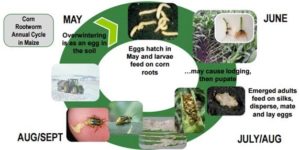by Mike Alme mikea@agpartners.net
Monsanto Technical Agronomist Austin Carlson put together a nice weekly summary for southeast Minnesota that I wanted to share. There are quite a few topics and links to fact sheets which are timely and of interest.
Soybean Aphids populations continue to grow. We have sprayed most of the acres and will continue to treat as thresholds dictate. Keep watching your fields if you have not treated.
White Mold has got its start. We have only had a few reports so far but conditions are right for its development. We expect to see more of a problem as we get to the end of August.
We put out several traps for Corn Rootworm Beetles in each location this year. Overall the pressure was light. Analyzing the trap counts, we were catching the highest numbers of beetles in areas with corn on corn rotation. This is expected and we are seeing good trait protection those fields.
Corn leaf diseases have not been a major problem yet. Over the next month it will be important to look at your fields to assess disease pressure and document which ones you are experiencing. You don’t want to get caught off guard on a susceptible variety that you tried new this year, plant more acres next year and it becomes a bigger problem. Please call up one of our Agronomists and go on a tour of your corn fields. As the ear fills the plant will give you clues on how to improve your management for next year.
Have a great week.
GDU Update
Goodhue
| Planting Date | 2017 GDU’s | Average |
| 4-24 | 1668 | -155 |
| 5-1 | 1646 | -135 |
| 5-8 | 1600 | -128 |
Estimated Black Layer Date
Based on a 100-103 day hybrid I would anticipate early May plantings to black layer/physiologically mature around September 28th – October 12th. Planting date, CRM, and future GDU accumulation may change these dates.
Xtendimax
If you have any inquires with Xtendimax (weed control, crop response, offsite movement, etc.) please have the grower call 1-844-RRXTEND and they will walk you through next steps (only takes 3-5 minutes). This should be your first call.
Soybean Aphids
Keep an eye on aphid levels. Favorable conditions: 75-85 degree weather. This weather could increase survival rates and reproduction rates. Below is a quick article that discusses scouting, thresholds, and management.
http://www.aganytime.com/Documents/ArticlePDFs/SoybeanAphidManagement_AS.pdf
White Mold
Favorable conditions: Rain, 65-75 degree weather, and heavy dews. Below is an article that discusses fungicide use and the effect of Cobra herbicide on white mold suppression.
Foliar Diseases in Corn
Northern corn leaf blight favorable conditions: Rain, 65-85 degree weather, and dews. So far NCLB pressure has been minimal but environmental conditions are favorable.
http://www.aganytime.com/Documents/ArticlePDFs/ManagingNorthernCornLeafBlight_DK_Spotlight.pdf
Goss’s Wilt pressure has also been low but hail and wind injury favors infection.
http://www.aganytime.com/Documents/ArticlePDFs/Goss%E2%80%99s%20Wilt%20FactSheet%20-%20DEKALB.pdf
Northern Corn Leaf Blight Goss’s Wilt
Corn Rootworm Beetles
They are out there! Scouting and counting CRW beetles now will give us an idea of current population that may be feeding on silks and it will also help estimate pressure for the upcoming year by counting the number of females laying eggs.












